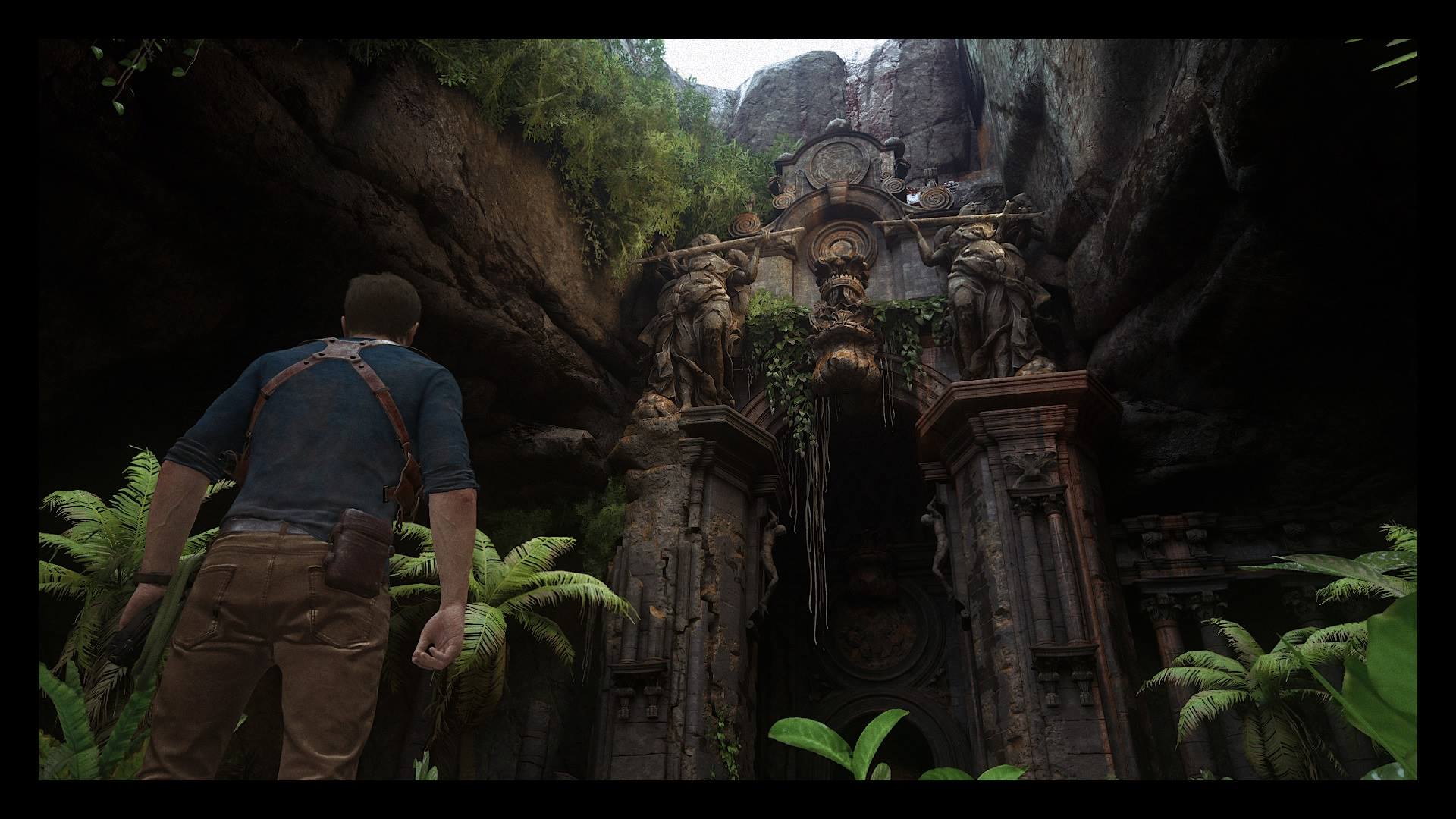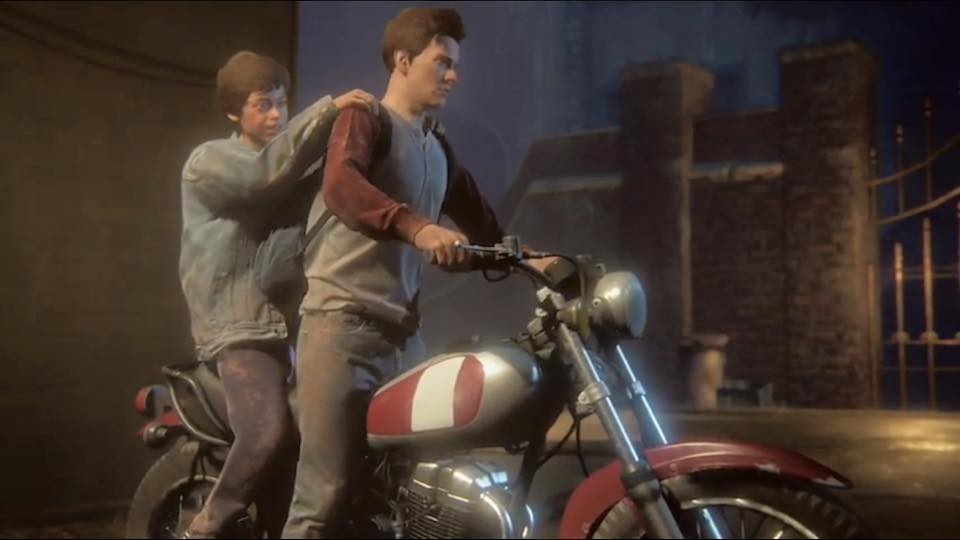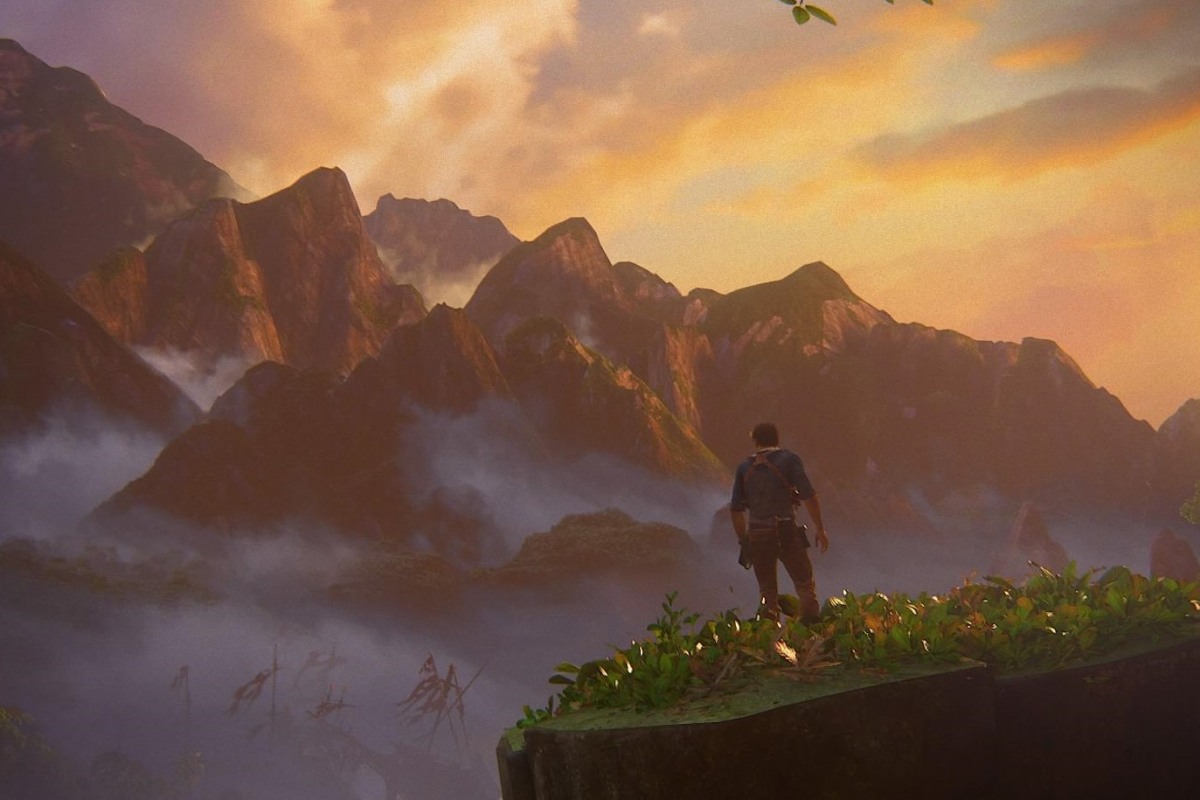Please note that this isn’t a review, as such. It also contains some spoilers.
Another year, another Uncharted game finished. But this wasn’t any Uncharted game, it was the last one. Ever. Assuming another studio doesn’t pick it up, that is. It’s been a long road for Naughty Dog, for Nathan Drake and for the fans, and a period of mourning is inevitable.
Several people have asked me for my thoughts on Uncharted 4: A Thief’s End, as Uncharted, in general, has been something I have had a lot of thoughts about over the past 9 years. I still remember the day my husband (then my fiancé) tried to persuade me into the purchase of a PS3 at a time we were both planning to move house and get married. “I think you’ll like this game,” he said, loading up the Uncharted: Drake’s Fortune trailer.
So what if our wedding cake had fewer tiers than planned?
Since then, the ride has been… special for me. Uncharted and my love for it has opened doors. It led to a dabbling in games journalism, to the extent of interviewing Jonathon Ross on the red carpet at the BAFTAs, and looking through the eyes and into soul of Troy Baker as angels sang and time stood still. Because of Uncharted I have been inspired to write creatively; a hobby that gives me great pleasure. Uncharted has brought me into physical and digital contact with so many amazing people from all around the world; both fans and developers alike.
It is fair to say, then, that the final Uncharted was always going to be a big deal. Always.

No write up of Uncharted 4 can be complete without referring to the pivotal moment in its development; the moment that knocked the wind from my sails. I woke one morning to the news that writer and Creative Director Amy Hennig and Naughty Dog had ‘parted ways’. You remember it. I won’t go over it, except to say that since that point, there was uncertainty. Would they continue? How would this affect development? Would Uncharted still be Uncharted? And what would Amy go on to do? In the interests of full disclosure, over the years of my involvement in Uncharted fandom I have come to know Amy and I am lucky enough to be able to call her a friend. She is awesome and supportive, and I am grateful not only for her creative output, but also for her friendship. That said, you can see how difficult Uncharted 4 was always going to be, personally, without her leadership. It has also caused me inner turmoil when faced with producing this article. How much influence does this have on my writing? I have to bear it in mind, and so long as I do so, I also have to be able to trust my own opinions.
Uncharted 4: A Thief’s End follows Nathan, his long lost brother Sam, Sully, and Elena on the trail of the treasure of Captain Henry Avery, the legendary pirate who retired after pulling off the largest heist in history. It is Sam who has the initial interest, and in their younger days, he and Nate search for it with Rafe, a mega rich guy who wants the glory. It goes a tad wrong, and Sam is presumed to have bitten the dust, when in fact he is merely incarcerated. The adventure kicks off again when Sam barrels back into Nate’s life, citing a need to pick up the trail once more, in order to pay off some mean guys he shared a prison cell with.
In some of the early scenes, we see Samuel (a few years Nate’s senior), busting Nate out of the St Francis Boys’ Home where they had been left by their father following their mother’s suicide. What is particularly lovely about these scenes is that this is the first time we have really seen Nathan learning something. Sam shows him where to climb, and encourages him when he worries about missing a jump. This is Nathan-before-Nathan, and it is charming. Young Sam is played by Chase Austin, and is one of the standout performances of the game. He is gentle, mischievous, and witty. It is somewhat unsurprising that Nathan looks up to him in the way he does.
We also learn that Nathan and Samuel’s mother was a gifted historian with much to offer the world of academia. Her career was cut short by her illness which also left her two sons alone in the world. Since the dawn of Uncharted fandom there has been an obsession to find out about Nate’s father – was he some hotshot treasure hunter or a criminal in whose footsteps Nate might follow? Would he eventually turn up? Who was he, and who *is* he? Some speculated that one of the characters seen in one of the trailers *must* have been the father, because we *must* know, right? But ultimately Nathan and Samuel’s father was dismissed as ‘always the arsehole’. It was their mother who laid all the genetic groundwork. A lovely subversive touch.
These young Nate and Sam scenes are also slightly problematic, though. Uncharted 3: Drake’s Deception sees Nathan’s past painted as one so utterly hopeless and broken that he had to invent a new identity to escape its horrors. The name ‘Drake’ is used to such powerful effect. It is not the name that makes the person, it is their deeds. Nathan often tells people proudly why his name is ‘Drake’ and from whom he is descended. It’s tragic. However, this effect is seriously diluted when we learn the real reason behind the adopted name.
To evade the police. That’s it.
Nate’s mother had a theory that Sir Francis had heirs. Sam merely suggests the two of them change their name when a misdemeanour goes tits up and they need to make a getaway. All the emotion and tragedy and depth behind the identity crisis explored in Uncharted 3 is actually pinned on a snap decision. One thing I never wanted to know was Nathan’s birth name, as it means absolutely nothing and adds absolutely nothing. It’s Nathan Morgan. Great. And what happened to Father Duffy, the guy who “wasn’t ready to give up on Nate”? We never hear about him again. Nathan didn’t run away because he felt abandoned, and because no one was there for him; he ran away to avoid getting into trouble.

Other than a breath taking opening sequence, the first third of Uncharted 4: A Thief’s End feels interminable. It jumps around in timelines, so just as you get excited about the idea of snooping around a big house in search of some of Mrs Cassandra Morgan’s things, you find yourself being punched in the face in a Panamanian jail.
Or eating pasta with Elena at their very smart looking house filled with tasteful bits of stuff picked up on their journey. You find Nate in his attic, and you have the option to pick up and inspect some of his mementos. These are items which reference the first three games, and it is a quiet moment of nostalgia. However, you as the player choose what to interact with, so this is no longer about Nathan, and what is important to him, but rather about a trip down memory lane by and for the player.
Nathan’s holster hangs on the wall, and there is not a real firearm within it, but a toy one. You can pull it out and shoot at a couple of things dangling from the ceiling. Again, it’s cute and fun, but it just suggests that Nathan and his previous adventuring lifestyle lacked maturity. And this is an overriding theme throughout the game – he’s grown up, moved on, and has been lobotomised along the way. It is not until one of the very last scenes of the entire game that this is addressed, and mercifully Elena comments that in their attempt to live a normal life, perhaps they have ‘over steered’.
Once the dragging opening act is over, Nathan and Sam go on a jaunt to Scotland, and finally it begins to feel like Uncharted. You climb, you explore, and you solve puzzles. Where this game truly stands out is the visuals, the mechanics, and the acting. It is lovely to get back to proper adventuring with Nate and crew. As you follow the clues on the trail left behind by Henry Avery, the historical aspect of Uncharted unfolds. The story of the pirates and their obsession with treasure is beautifully echoed in the modern day story.
Honestly I was expecting this game to be mostly about the relationship between two long separated brothers, but the thread of pure spun gold that is beautifully woven into the complete yarn is that of a husband and wife and their struggles to adapt to what they see as ‘normal’. The fact that Elena actively tries to persuade Nathan to go on a little safe adventure towards the start of the story suggests that she truly does know him. But Nate’s refusal and later massive lie about where he is and what he is doing belies the vulnerability and fragility in him that has always fascinated me and made him so interesting. He makes some lame comment when he is spectacularly called out on his lying about how he was ‘trying to protect’ her. Nate; have you *met* your wife? The one who punched you square in the jaw after easily tracking you down in 2007? The comment is retracted when he eventually admits it was himself he was trying to protect. He couldn’t face losing her. Apparently he *hasn’t* met his wife (‘cos she would never not understand him) but at least his reasoning is based on a legitimate fear that you can well expect a man like Nathan Drake to have.
It has to be noted that the performances of Emily Rose and Nolan North (Elena and Nathan) are utterly top notch and I fully expect them to win all the awards. They have been in Uncharted from the very start, and it some ways it propelled them both onto the biggest stage. You can imagine that both are very fond of the two characters, and they give this swan song their every last bit of effort. And by god it pays off. You feel their love for each other; at times I felt a little intrusive. I kinda wanted to give them some alone time so they could sort their shit out. The emotional punch is multiplied by the technical beauty of Uncharted 4. It is clear that the animators threw everything and the kitchen sink at making us truly believe everything that Nolan and Emily were portraying.

Ultimately I have also come a long way with Nate and Elena, and while I found Sam to be an interesting and complex character, it isn’t him I want to know more about, especially given that this is almost certainly the last time we get to spend any time with the Drakes. Sam isn’t the only character to be introduced to us in Uncharted 4 – along with a few minor characters (Father Duffy, where are you???) we also meet, unsurprisingly, some new bad people. The two head honchos are Nadine Ross, and Rafe Adler. It has to be said that as villains go, these guys are pretty awesome. Nadine kicks your sorry arse from here to Kentucky on a couple of occasions, and I appreciate the fact that Naughty Dog didn’t stray into “ooh can’t hit a girl” territory. I was also pleased by the depth of Rafe. He has enough money to never need to steal a thing, or work for a thing, but he is driven by a need for glory and to prove that life doesn’t have to be handed to him on that silver platter. This drive, coupled with charisma and psychopathy, make him, I think, one of the best antagonists Uncharted has seen. (I am still besotted with Atoq Navarro, though, and his drive simply to screw over his boss.)
All in all the story itself is enjoyable; I just have those few issues with how it is told, the pacing, and what it does to previous entries in the series. But of course, Uncharted 4 isn’t just a story. Gameplay and mechanics wise, there are several additions; a grappling hook, a slidey down a hilly thing, a hiding in long grass stealth trick, and a helpful climbing peg thingy. I can’t tell you how much I loved hiding in long grass and pulling Bad Guys to their doom one idiot at a time. At one point Nate and Elena were sitting on a pile of bodies so large there was barely enough space left for them in the grass for themselves. This and the stealth system in general works really well (and thank god for that when playing on Hard), and rather than being a chore (I am not always the single most patient person on the planet) it was a delight. The AI has been tuned as well – to the point that the Bad Guys will inform each other when they come across one of their dead pals. This is cute, but kind of hilarious when you have obliterated 20 of them with bullets, hidden yourself again, and snapped another neck. “One of our guys down!” Yes… along with all your other mates…! Anyway – stealth is great.
The grappling hook… not so much. Not because it isn’t fun, but because – why the hell didn’t Nate take it on all his previous adventures? Seems like it might have been useful. It was something Sam introduced him to way back when. It feels like a “what can we add, what can we add, what can we add? Oh – grappling hooks are cool!” Yes, they are, but they don’t work when you consider Nathan’s history.
Set pieces are something Uncharted has been known for since forever, and Uncharted 4 packs them in perhaps like no other game. But they all feel somewhat familiar, and that is because, for the most part, they are. While this adds to the nostalgia in what is Nathan’s swan song, it does feel a little unoriginal. And as I am all about the narrative, and what it tells us about Nathan and chums, again this feels more about the player than the characters. It serves to make the world feel less like a place where heroes and villains race for treasure, and more like a playground (albeit an incredibly pretty one) for some (incredibly pretty) avatars.

And this is a recurring and niggling irritation for me – Uncharted 4: A Thief’s End considers the players more than it considers the characters. Even little tiny things like having to press triangle to ask Nathan to take something from another character, to larger things like optional dialogue. Nathan’s story is one to uncover. It is not one for us to write ourselves. Ultimately, the dialogue options are minor and don’t alter any of the overall story line, but having spent so much effort in previous instalments on making Nathan feel real, human, and strangely autonomous for a character in interactive media; it is such a shame to make him… an avatar again.
Uncharted 4 asks us to imprint too much of ourselves onto an already masterfully created character. This is amplified by the removal of a proper Nate’s Theme 4.0. Greg Edmonson’s original theme did so much to help create Nate, and how we see him. Who didn’t love firing up their PS3 and having that sweeping theme sing you into a great adventure? Now the loading screen is silent and bland. I did appreciate the film style title sequence; but you see that once and it’s gone. While Greg’s complete score will remain with me forever, the score for Uncharted 4 is sadly, ultimately forgettable.
With all this negativity, you might think I did not enjoy Uncharted 4. This is not the case. But in many ways I simply would rather it weren’t an Uncharted game, because it isn’t, really. In an attempt to make it a more mature experience, a lot of the warmth, charm, and humour of the original three games has been stripped out. There are beautiful moments, and beautiful details (people painting walls, screes that collapse when you shoot them, characters who react to torchlight), but I would happily lose all this just to feel like I was playing an Uncharted game all the way through. Where Uncharted has been known for tuning everything up to 11, now it has been dialled back to 9. I am aware, of course, that a lot of this comes down to personal preference, but I am trying to consider Uncharted 4 in the context of all Uncharted games and narrative. The difference in directing styles between Amy Hennig and Neil Druckmann is obvious. For me – Amy’s style works best, others will think otherwise, I am sure. It was said repeatedly during production, (and to the point of grating on my nerves) that Uncharted 4: A Thief’s End would be the last Uncharted; at least the last to be made by Naughty Dog. Honestly? I am OK with that. I don’t, however, think the end was such that another would be “really hard”, but it is clear that Naughty Dog are more than ready to move on. I look forward to seeing what they do next; they have never made a game that wasn’t excellent.

